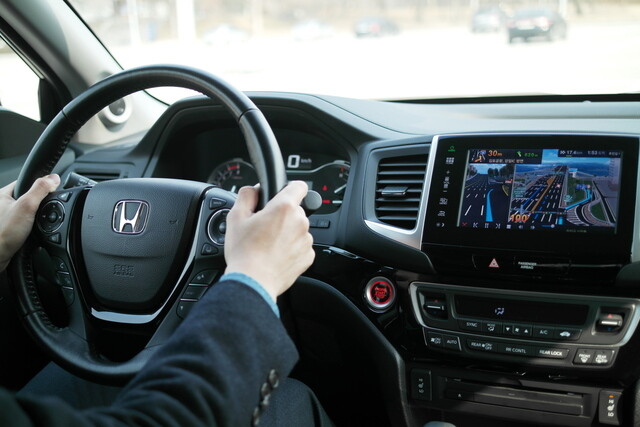hankyoreh
Links to other country sites 다른 나라 사이트 링크
Imported car companies implementing Korean-style navigation systems

Imported car companies are adopting a “Koreanized navigation” strategy in response to complaints over the long navigation update cycle.
Japanese automakers were the first to adopt this kind of “Koreanization” strategy. According to accounts from imported car industry sources on Mar. 23, Toyota Motor Korea has been installing South Korean Mappers navigation in its locally marketed models since 2011. Honda Korea has added South Korean navigation to its Accord since 2015. The main reason for the decision was complaints from consumers that the update cycle was too long. At the time, updates occurred roughly twice a year. While this was tailored to head office standards, it ended up a source of disgruntlement thanks to local characteristics in South Korea - including periodic changes in street and store names - and local consumers’ IT device standards.
BMW has been partnering with a South Korean map company. After setting up its own R&D center in South Korea in 2015, the automaker joined forces with a local map data supply company to develop a South Korean navigation system last year. The system was included in its recently launched New 7 series. Jaguar Land Rover Korea has become the first imported car maker to allow linking with the smartphone navigation TMap via application.
Mercedes-Benz Korea, which topped the list for imported car sales last year, continues to install its own navigation systems. Update cycles are one to two per year, and users must pay additional costs every time.
Among domestic automakers, different products are used for different completed vehicle companies. Hyundai-Kia includes navigation made by its own affiliate Hyundai Mnsoft.
No precise statistics are available for the navigation market. According to the Korea Automobile Manufacturers Association and other sources, around half the 1,542,000 domestic cars sold in South Korea last year had navigation systems included, while the remainder are believed to use aftermarket systems installed separately by the buyer. The navigation market previously experienced rapid growth, climbing from 100,000 units in 2003 to 1.3 million in 2006 before reaching a peak of 1.75 million in 2010. The scale of the market has decreased by 15-20% per year since 2011 due to an increase in smartphone navigation users.
By Ko Na-mu, staff reporter
Please direct questions or comments to [english@hani.co.kr]

Editorial・opinion
![[Column] Season 2 of special prosecutor probe may be coming to Korea soon [Column] Season 2 of special prosecutor probe may be coming to Korea soon](https://flexible.img.hani.co.kr/flexible/normal/500/300/imgdb/original/2024/0426/3317141030699447.jpg) [Column] Season 2 of special prosecutor probe may be coming to Korea soon
[Column] Season 2 of special prosecutor probe may be coming to Korea soon![[Column] Park Geun-hye déjà vu in Yoon Suk-yeol [Column] Park Geun-hye déjà vu in Yoon Suk-yeol](https://flexible.img.hani.co.kr/flexible/normal/500/300/imgdb/original/2024/0424/651713945113788.jpg) [Column] Park Geun-hye déjà vu in Yoon Suk-yeol
[Column] Park Geun-hye déjà vu in Yoon Suk-yeol- [Editorial] New weight of N. Korea’s nuclear threats makes dialogue all the more urgent
- [Guest essay] The real reason Korea’s new right wants to dub Rhee a founding father
- [Column] ‘Choson’: Is it time we start referring to N. Korea in its own terms?
- [Editorial] Japan’s rewriting of history with Korea has gone too far
- [Column] The president’s questionable capacity for dialogue
- [Column] Are chaebol firms just pizza pies for families to divvy up as they please?
- [Column] Has Korea, too, crossed the Rubicon on China?
- [Correspondent’s column] In Japan’s alliance with US, echoes of its past alliances with UK
Most viewed articles
- 1Samsung subcontractor worker commits suicide from work stress
- 2Division commander ordered troops to enter raging flood waters before Marine died, survivor says
- 3‘We must say no’: Seoul defense chief on Korean, USFK involvement in hypothetical Taiwan crisis
- 4No good, very bad game for Korea puts it out of Olympics for first time since 1988
- 5[Column] Season 2 of special prosecutor probe may be coming to Korea soon
- 6[Editorial] Korea’s surprise Q1 growth requires objective assessment, not blind fanfare
- 7Korea’s 1.3% growth in Q1 signals ‘textbook’ return to growth, says government
- 8US overtakes China as Korea’s top export market, prompting trade sanction jitters
- 9[Column] Has Korea, too, crossed the Rubicon on China?
- 1046% of cases of violence against women in Korea perpetrated by intimate partner, study finds